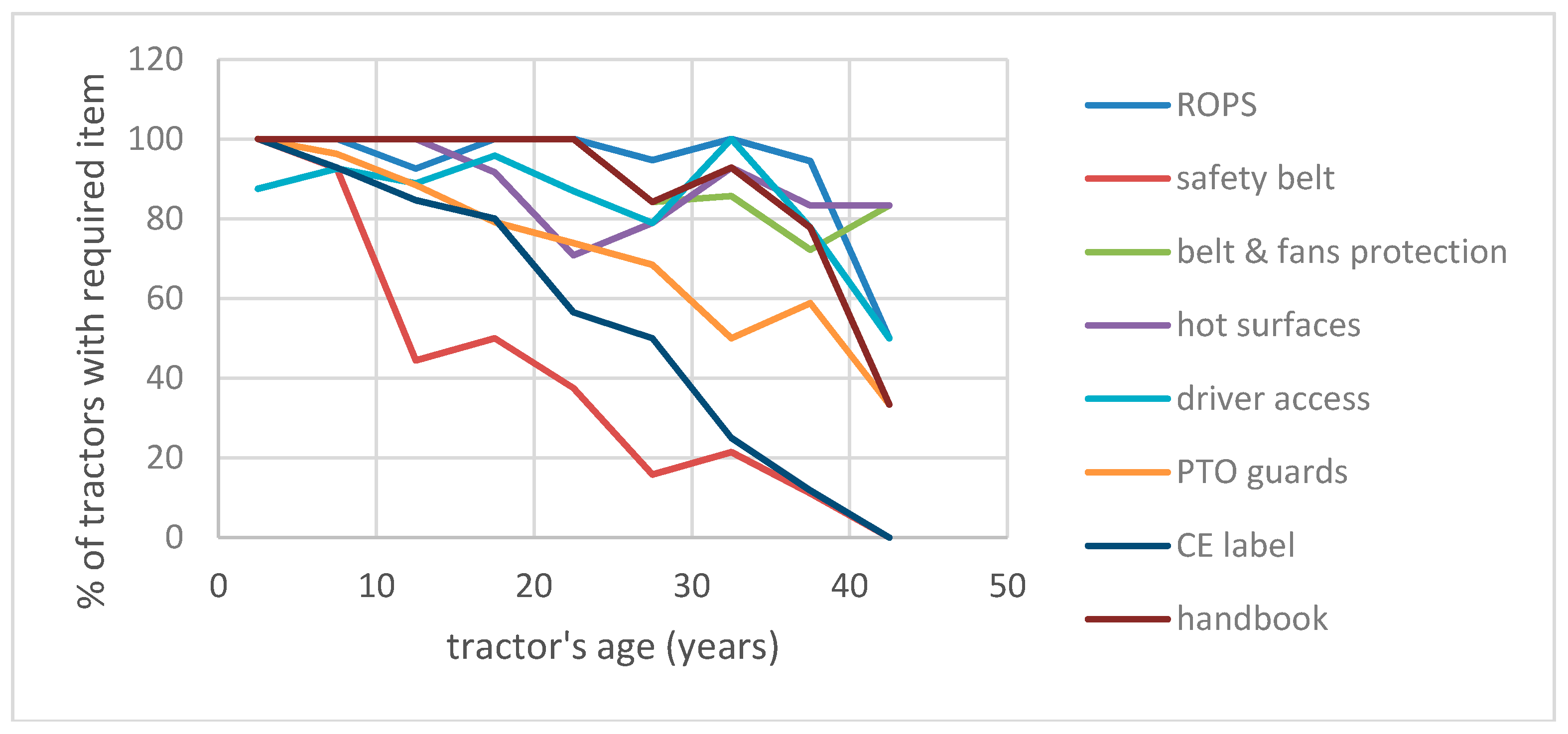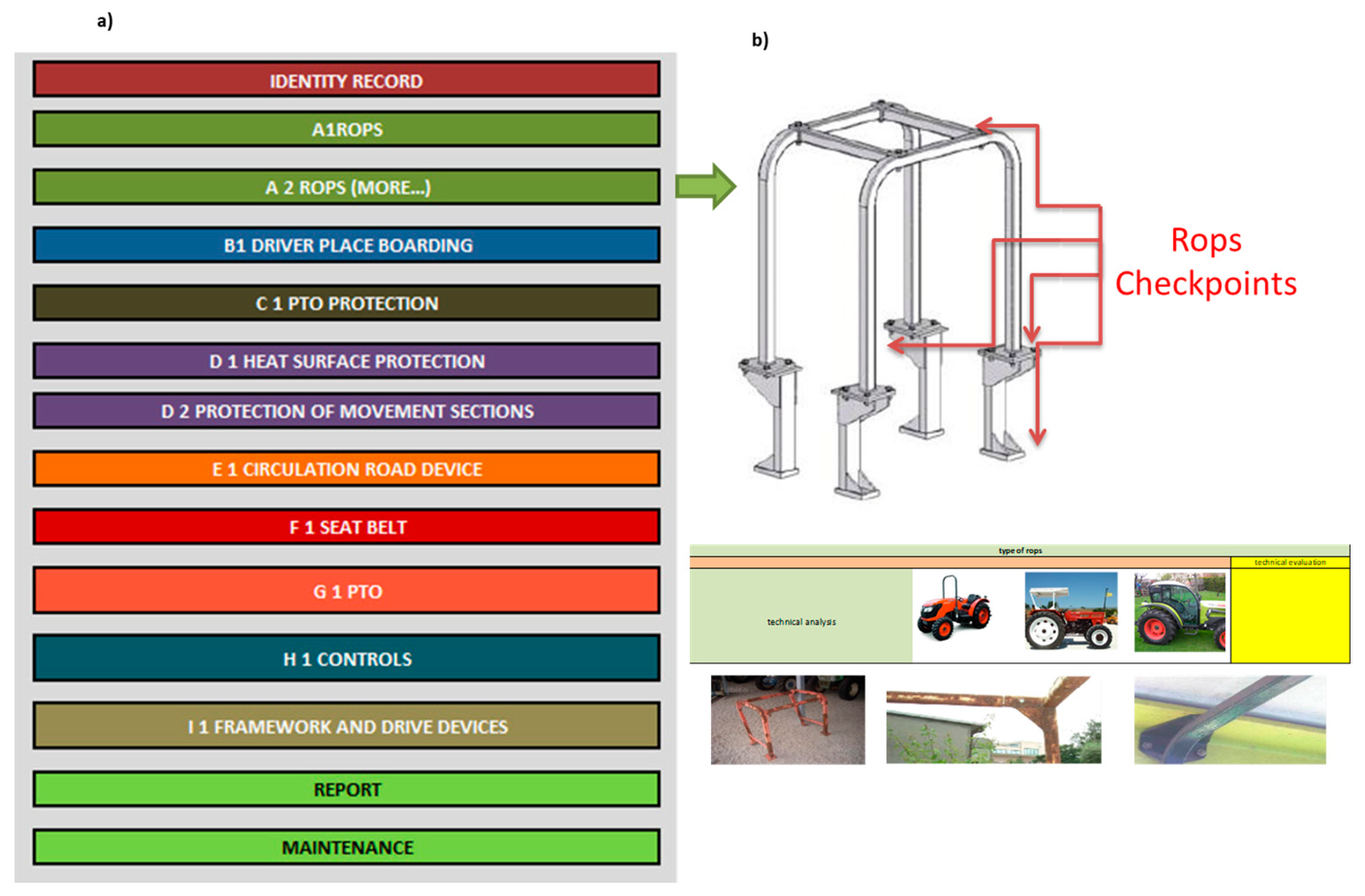3.1. First Level Analysis
Table 2 includes only 58 farms with external personnel, which are subjected to full application of Italian Law 81/08, including official documentation. The main document required, i.e., the Risk assessment document, was absent or inadequate in 34.5% of the farms; other required documents were even more often missing, including a scheme for medical surveillance of workers (34.5%), the scheme for emergency procedures (41.4%), and the record of periodic inspection of lifting equipment (44.8%).
Only those documents provided by third parties were mostly present, such as the Compliance certificate (lacking in 10.3% of farms), the Book of use and maintenance of equipment (8.6%), the Pesticide safety sheet (25.9%), or those required for purchasing pesticides (Pesticide license: 24.1%). Particularly remarkable was the absence of a plan for machinery and equipment maintenance (in 36.2% of farms), because of its great importance for accident prevention.
The Italian law also requires every farm with hired personnel to officially appoint a number of figures in charge of the different protection and prevention services (
Table 3). While a safety manager (or head of the prevention and protection service, PPS) was mostly present (82.8% of the farms), other figures were often missing, including a doctor designated for periodic medical surveillance (48.1% of farms), or the supervisors for fire prevention (33.3%), first aid (34.6%) and workers’ safety during work (63.0%). Additionally, 38.3% of the farms were not providing the workers with sufficient training and information services, while 44.3% did not have any special training for the various managers and supervisors.
Most of the farms had adequate toilet and shower services and dressing rooms for the workers (
Table 4). The width of the main entrance to the farm (minimum: 5 m) was mostly in line with the law. However, protections on gaps or trenches were missing in 28% of the farms. Most remarkable was the absence of any Interference risk analysis, i.e., a plan to avoid risks owing to the presence at the farm of external personnel, especially contractors for cereal or grape harvesting. Only 8.6% of farms had conducted a proper analysis of such risks.
In approx. one half of the farms, a specific analysis was made to assess the main features of the tractors (
Table 5). The average nominal power was 63 kW, and the average age was 20.9 years. The average annual usage (328 h/year) was related to the small average land area (63.9 ha,
Table 1), and was far from the level suggested for profitable management (at least 600 h/year). These data offer some clues as to the current difficult economic situation in most of the farms: the reasons are many, and they cannot be fully discussed here. Nonetheless, this makes it even more difficult for these farms to bear the costs involved by current requirements for risk prevention and protection.
In fact, missing protection devices are mostly related to the tractor’s old age. In most of the sample farms, tractors were equipped with roll over protection structures (ROPS), protection of moving parts, such as belts and fans, and of hot surfaces (
Table 6). However, a safety belt was missing at the driver’s seat in 55.1% of the tractors—even though it has been declared mandatory since 2005. PTO (power take off) guards were also missing in 24.7% of the tractors (the study has analyzed in a different and specific way the part of the PTO, as it is often the cause of fatal accidents).
The relationship between the presence of protective items and the tractor’s age is shown in
Figure 2. All of the new tractors were in line with legal requirements, the only exception being the safe access to the driver’s seat; Italian law requires the presence of two handles and stairs for tractors that have a distance exceeding 0.55 m from the ground (Annex V of the Italian Law 81/08) but this is often difficult to attain especially in small tractors for viticulture. This means that the main problem for these farms is the low investment capacity, which makes it difficult for farmers to replace old tractors with new ones.
Figure 3 shows the percentages of farms providing their workers with personal protection equipment (PPE). In general, only basic PPE were present (like cotton overalls and mechanical protection gloves), while specific PPE were seldom found (such as ear muffs, safety foot-ware, chemical resistant clothing and gloves and chemical resistant respirators).
The main findings from the survey suggested that several agricultural farms were sufficiently aware of the risks associated either with their specific production systems, or with the machinery used, to some extent, particularly in order to avoid the related economic costs. More importantly, information about legal obligations was generally poor, as was the understanding of the possible cost, in terms of fines, damage compensations etc. which failure to comply with the rules might cause.
This suggested that most farms would take advantage of some simple informative tool, e.g., in the form of a software, to quickly detect the most critical situations. This software, based on a Microsoft Excel
® worksheet (
Figure 4a), enables the farmer to check all of the legal requirements for tractors and the main agricultural implements, and suggests how to amend possible defects.
For instance, it is possible to examine the existing ROPS on a tractor (
Figure 4b), and understand whether it fulfills legal requirements or it needs changes or replacement; furthermore, indications may be given on how to install a ROPS on an old tractor.
3.2. Second-Level Analysis of the Sample Based on 11 Farms
The second survey investigated three groups of farms: vineyard farms, cattle and cereal farms, and a third group of mixed farms (
Table 7). This involved an overall number of 58 agricultural tractors.
In the vineyard sector, the mean age of tractors was lower (5728 total h and 14.2 years) compared with both the Cattle % Cereals group (8046 h and 25.2 years) and with the average of the remaining farms (8557 h and 24.3 years) (
Table 8). On the other side, the annual use is higher in the vineyard sector (502 h/year, versus 351–370 h/year).
The fact that agricultural tractors in the vineyard sector are generally of a younger age implies that they have minor problems in terms of safety and efficiency. In fact, this particular agricultural sector is generally more proactive and prone to invest financial resources, mainly because companies have a higher profitability but also because they are normally larger and therefore more structured and less family-owned. This shows a clearer perception and higher awareness of safety issues and needs (
Table 8). Nonetheless, the present study also highlights some extremely important negative features, which can be of paramount importance in implementing corrective measures for the upgrading of current agricultural machinery inventories. In fact, farms dealing with working areas of more than 50 ha extension have been recognized as having the oldest agricultural tractors-with an average age of 25 years.
The main lack is in the power take-off guards (34.5%), followed by driver’s seat belts (24.1%), together with lack of hot parts protective shields (32.8%). Lack of moving parts protections (20.7%) and ROPS (19%) has also been highlighted by the study (
Table 9).
Tractor’s compliance with the law (% of required items that were indeed present) was analyzed versus the tractor’s age (in years) and the type of farm personnel (farms with and without external, hired workers, respectively). Both regressions in
Figure 5 were statistically significant (
R2 = 0.383 and
R2 = 0.453, respectively), showing that: in general, the percentage of compliant items decreased with increased age of the tractors; in particular, tractor compliance was lower in family farms independently of the tractor’s age. This can be explained by lower perception of risks in family farms, which certainly represents a failure of awareness campaigns conducted so far, but may also be related to the smaller economic size of these farms, and to the difficulty of bearing the costs involved by extensive equipment updating so as to meet the current requirements for risk prevention and protection.










